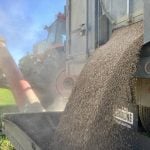In recent growing seasons, the disparity between corn and soybeans has been getting harder to ignore. The frustration has been getting harder to ignore too. Why can’t farmers raise their soybean yields as quickly and as reliably as their corn?
There’s little debate that corn yields have advanced greatly in the past 20 years, to the point where 200 bu./ac. harvests are far more common. Soybean yields have also risen, but not at the same rate.
To do an apples-to-apples comparison of the two crops is impractical given all their differences, i.e. physiological, environmental and agronomic. Yet the fact remains. Based on U.S. numbers, which seem very similar here, corn yields over the past 50 years have increased an average 2.0 bushels per acre per year. In soybeans, it’s 0.43 bushels.
Read Also

Sensing the soil: Root cell research finds ‘stress hormone’
Research into how root cells react to soil stressors could help plants better adapt to changes in their climate.
That doesn’t stop agronomists, advisers, researchers and growers from trying to push the limits on soybean yields. In the past five years, agronomists have been challenging growers to drive yields higher, often with a more focused management approach.
Drew Thompson, market development agronomist with Pride Seeds, points to the sense of tradition that surrounds corn production. Corn simply has more theories and research projects to study nitrogen rates and the effect of other nutrients, the critical weed-free period and the impact of various diseases, he points out.
“When people grow corn, they aim to do the best they can — rarely do you ever hear of growers not providing what’s needed,” says Thompson. “Soybeans have been viewed as a ‘plant, spray and harvest’ crop, and the challenge is that even with this minimalist approach — letting soybeans scavenge left-over fertilizer, dealing with the environment — yields can be decent, so why do more, why spend more money?”
Where Thompson has seen a significant change in yield, however, is on those farms that pay more attention to production and performance parameters including fertility, tilth and rotation.
Genetics undoubtedly has played a major role in boosting soybean yields, but it’s through maximizing the fullest extent of stress reduction — through weed, disease and pest management practices — that agronomists are seeing the biggest soybean gains.
Also important is that, for better or worse, while some growers have been working on such strategies for 20-plus years, they’ve been seeing the best returns just within the past five years.
“Improvements in genetics and technology are a huge part of the soybean yield challenge, and the most obvious example is in weed management,” says Thompson. “While a lot of focus does go into the technology development (like glyphosate-tolerant systems), the primary focus of breeding programs continues to be improvements in yield. Varieties are screened to ensure the agronomic package is sound, plus determine how the genetics handle different environmental and management decisions.”
Not so secret
In 2010, Fred Below, professor of plant physiology at the University of Illinois, came up with his “Six Secrets to Soybean Success” and he has been sharing that message ever since. His comments echo many of those made by Thompson, especially where the genetics of soybean varietal improvements are concerned as well as in enhanced management practices.
As much as a grower can help to boost yield, there are certain physiological facts that cannot be underestimated.
“When breeders select for high yield, in effect, they’re partially selecting for tolerances to stresses, including weather,” says Below. “There is what is known as ‘per se’ or inherent yield, and then there’s the yield that you realize because you don’t chip it away due to stress. Allegedly, most of the improvement in yield is due to better tolerance to stresses, and this includes things like water stress, temperature stress or tolerance to biotic stresses like disease or insect pests.”

Below’s “Six Secrets” include weather, soil fertility, variety, seed treatments, fungicide and row spacing. The major difference between this list and his “Seven Wonders of the Corn Yield World” is that for corn, the list is far more rigid in its order from one to seven. In soybeans, aside from weather always topping the list, the rest can shift positions from one year to the next, depending on conditions during a growing season. Some years, row spacing might be No. 6, in others it might be No. 2.
The key difference from Below’s viewpoint isn’t simply a matter of plant physiology (monocot corn versus dicot soybean) as much as it is the indeterminate growth habit of the soybean, and the length of time that its production can be adversely affected by different stresses.
Indeterminate refers to the plant’s ability to produce new leaves and flowers over a longer period of time than corn. The soybean plant’s strategy is to produce many more flowers than it will ever use, and then abort a number to bring the total down to what the environment and the level of agronomic management can support.
For instance, a soybean plant can produce blossoms for weeks, then abort 50 to 75 per cent of those blossoms and still produce a substantial crop. (It’s part of the reason why soybeans can compensate for thin stands.)
Such a resilient crop should be a candidate for enhanced productivity, yet Below suggests it’s a bigger challenge than that.
“It’s always easier (to boost yields) in a determinate crop like corn because you have a targeted time point in the crop’s life cycle where things really matter,” says Below.
He notes that the effects of stress in corn can be considerable in that shorter period, but once the plant sets kernels, stress is less of a factor. “In soybean, your reproductive period is a month or more. Corn determines its kernel ovule potential at a much earlier age than soybean, and it has one shot to make the ear and after that, it’s all downhill. So for instance, the critical weed-free period is much narrower in corn compared to soybeans.”
Is weather-proofing possible?
Here again, Thompson and Below agree that corn, even though it enjoys greater attention to detail from growers, is actually the more sensitive of the crops to things like weed competition. Yet Thompson points to the well-worn adage in soybean production that says, “beans are made in August” — another reflection of Below’s references to the indeterminate quality of soybeans.
“I also believe that the stronger the soybean plant as it enters August, the more beans there are to be made,” Below adds.
But is it possible to weather-proof soybeans? Not as part of any genetic selection process, says Below. But in paying greater attention to soil fertility, variety selection, seed treatments, herbicides and fungicides — paying as much attention to soybean production as in corn production — it may be possible to come close to making them practically weather-proof.
“When you select for high yield, you’re inherently selecting for all of those things (weather-related),” he says. “You don’t have to do it directly, but that’s what you end up with. Let’s say you properly manage a soybean — so you protect its seed germination, you fertilize it, get it into a good canopy and spray it for diseases and insects — the Six Secrets — you have a healthier plant and it may not be weather-proof, but it’s better for weathering the storm of less-than-optimum weather.”
From Thompson’s vantage point, the impact of such “weather-proofing” is centred on helping the plant deal with moisture, whether that’s too much or too little. And it goes beyond weed, pest or disease management, and includes more of that “total package” that more agronomists, advisers and researchers are talking about — soil health, rotations, organic matter and dealing with compaction.
“Typically, when we have too much moisture, it’s because of a heavy rainfall event, which can pound the soil and tighten the top few centimetres,” says Thompson. “Soils with good tilth due to rotation and organic matter additions are better able to handle this stress.”
On the too-little moisture front, he adds that genetics can help with enhanced root systems and rapid early-season growth that will steel the plant against any impacts of mid-season drought.
Lack of response is frustrating
No matter how closely a soybean field is managed, however, there is the common point of frustration that soybeans do not respond in the same way to increased management. In the past, says Below, fertilizer applications were expensive and beans were considered the crop that fed off corn’s leftovers.
But what also has an impact on the fertility side is the harvest index, i.e. the amount that the crop removes in the grain. Nitrogen is admittedly a lesser concern in soybean than in corn, but it’s phosphorus that’s the more important nutrient, with 80 per cent of what the crop takes up during the season removed by from the field in the grain.
“The way growers fertilize soybeans doesn’t supply enough phosphorus in-season to meet the needs of the soybean crop,” says Below. “Everybody knows corn has to have nitrogen every year — you can’t get along without it.”
Thompson understands growers’ difficulty, as well. Add more fertilizer to corn and the tendency is to see an economic response; add in a fungicide and there’s likely another positive response. Add the two together and there’s often a synergistic effect.
In soybeans, by contrast, the response to fertilizer, fungicides or other management practices is often harder to justify.
Some growers who consistently grow big soybean crops quickly learn they’re enhancing their systems with other management practices, including early planting and additional fertilizer and fungicide applications. The unfortunate thing is there’s little research data to show the long-term benefits of those scenarios.
“But the one underlying factor surrounds stress abatement. When a crop is stressed, it can’t perform to its genetic potential,” says Thompson. “Remove stresses and the yields should go up.”
This article was originally published in the October 2018 issue of the Soybean Guide.
















